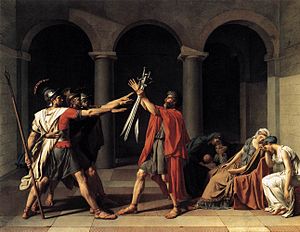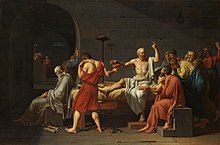The oath of the Horatians

|
| The oath of the Horatians |
|---|
| Jacques-Louis David , 1784 |
| Oil on canvas |
| 330 × 425 cm |
| Musee du Louvre |
The oath of the Horatier (French Le Serment des Horaces ) is a painting by Jacques-Louis David, completed in 1784 . The large-format picture (330 × 425 cm) was painted with oil paint on canvas and is now in the Musée du Louvre in Paris .
Origin and subject
The commissioner for the painting was the Minister of Fine Arts of the government of King Louis XVI. of France . The motif itself was up to the artist, only the size was fixed, which David expanded in the course of the creation phase. He decided on the story of the struggle of the Horatians against the Curiatians , which was handed down by Livy ( Ab urbe condita ) , which took place between 672 and 640 BC. Should have taken place. Livy reports about it in the context of the war between Alba Longa and Rome .
Due to disputes and mutual cattle theft between the two cities, they were enemies. Rome declared war on Alba Longa, but since the Etruscans threatened both cities and they still needed all the armed forces, the cities agreed on a proxy battle between three brothers capable of arms. In Alba Longa the fighters were chosen from the Curiatian family, in Rome from the Horatian family.
The brothers were proud that they had been chosen, even though it contained a conflict that could not be easily resolved, because both families were related by marriage : Sabina, sister of the Curiatians, was married to a Horatian; Camilla, his sister, was engaged to one of the Curiatians, who was also her brother's friend.
Only the youngest of the Horatians returned from the substitute fight, albeit as the winner. Because when his two brothers had already fallen, but the Curiatians were only wounded differently, he used a ruse: He appeared to flee in the correct expectation that the opponents would not all be able to pursue him at the same time. Unexpectedly, he then stood up again and killed all three, first the fastest because he was only slightly injured, and lastly the most seriously wounded.
When he returned to his family, his sister Camilla burst into tears for her fiancé who was killed. Thereupon he drew the sword and killed her with the words: “Away with you to your fiancé and your misplaced love! You have forgotten your dead brothers and the living, you have forgotten your hometown. This is how every Roman woman who mourns the enemy should go there! "
The oath that David represents does not appear in Livy , nor in any of the other authors (e.g. Plutarch , Valerius Maximus and Dionysius of Halicarnassus ). Even in the play " Horace " by the playwright Pierre Corneille he is not shown. This piece, which premiered in Paris in 1640 and which had patriotism and popular power as its main theme , was well known to Parisian society at the time of David, and the artist himself was enthusiastic about the performance. With this, David had found his motive for the state commission and went to Rome with his family specifically to look into the world of forms of antiquity.
Image description
In his image composition , David arranges the action parallel to the image as if on a stage. With the dark background of the arcades, he used the unpredictable depth as a backdrop, as it were. Composition and statement coincide in one thing: the focus is on the task of going to arms , personified in the father figure. The swords also flash in the center, the outstretched oath hands point to the weapons that indicate the impending deed. The finely graduated angles of the arms form a harmonious triad. The different design of the swords formulates an additional aspect: This is not uniform preparation, but the spontaneity of individual enthusiasts.
Behind the father's back the viewer looks at a group of women with two small children. The blonde young woman with the white veil in the foreground is interpreted in literature as Sabina, the sister of the Curiatier. The woman on the far right is supposed to represent Camilla, the sister of the Horatians. Her left arm hangs down limply, and she leans forward weakly. While the group of men is steeped in dynamism and struggle, the women show sadness, fatigue and resignation.
In the lower left corner the artist has signed his work as follows: “L. David fecit | Roma anno | MDCCLXXXIV. "
Meaning and reception

With the completion of the Horatian oath , David heralded classicism . Although his painting was by no means intended to speak out against the conspiracy against the authority of the state, the portrayal was interpreted in this direction in the tense atmosphere of the pre-revolutionary years . For the artist himself, the picture was a triumphant success. The audience was overwhelmed by the break with the baroque style tradition. Here, for the first time, the unity of time and action was obviously integrated into a consciously sober composition. The audience knew the story of the passionate sacrifice of these heroes and was also aware that the grieving women in the picture represented the premonition of the tragic outcome.
After many setbacks, David owed his rise to fame to this painting. The reporter for the Teutscher Merkur wrote from Rome: "Not only the artists, lovers and connoisseurs, but even the people run in troops from morning to evening to see it ... no election of the Pope has ever set the minds in motion," so the writer, deeply impressed by the "ancient simplicity" . Shortly thereafter, was in the Journal de Paris to read: "... at the sight of this painting you will be gripped by a feeling that elevates them soul and to work with Jean-Jacques Rousseau to speak, a little heart uplifting, has the one excited." Although it was the stiff, statuary figure position was soon reprimanded, but in public, especially in the Salon de Paris , it was precisely this change in style that met with enthusiasm.

David had other paintings of this kind followed, such as Socrates, drinking the poison cup (1787) and Brutus, to whom the corpses of his sons are brought into his house (1789). However, it was the oath of the Horatians , which became the program image of the French Revolution and later also earned the artist a seat in the National Convention .
literature
- G. Bazin: Jacques-Louis David. In: Rolf Linnenkamp (ed.): Kindler's painting lexicon in six volumes. Volume 2, Zurich 1965, pp. 37–44.
- Anita Brookner: Jacques-Louis David . London 1980.
- Thomas Crow: Painters and Public Life in Eighteenth-Century Paris . New Haven 1985.
- Norberto Gramaccini: Jacques-Louis David's “Oath of the Horatians” - The révolution des arts and the Roman Seicento. In: Victoria v. Flemming, Sebastian Schütze (Ed.): Ars naturam adiuvans. Festschrift for Matthias Winner on March 11, 1996. Mainz 1996, pp. 557–571.
- Francis Haskell: The Story and Its Pictures. The art and interpretation of the past . Munich 1995.
- Hans-Jürgen Hillen (Ed.): Titus Livius, Roman history . Book I-III, Munich / Zurich 1987.
- F. Kleiner, C. Mamiya, R. Tansey (Eds.): Gardner's Art through the Ages. 11th edition. Volume 2, USA 2001.
- Ewa Lajer-Burcharth: Necklines. The Art of Jacques-Louis David after the Terror . New Haven 1999.
- E. Mai, A. Repp-Eckert (Ed.): Triumph and death of the hero. European history painting from Rubens to Manet. Cologne 1987.
- Bernd Roeck: The historical eye. Works of art as witnesses to their time. From the renaissance to the revolution. Göttingen 2004.
- Warren Roberts: Jacques-Louis David, Revolutionary Artist. Art, Politics, and the French Revolution . North Carolina 1989.
- Elmar Stolpe: Classicism and War. About the history painter Jacques-Louis David . Frankfurt am Main / New York 1985.
- Rolf Toman (Ed.): Classicism and Romanticism. Cologne 2000.


